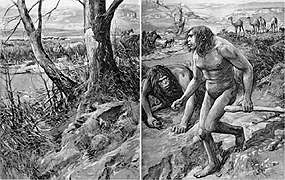Artist's impression
An artist's impression, artist's interpretation, or artist's rendition is the representation of an object or a scene created by an artist when no other accurate representation is available. It could be an image, a sound, a video or a model. Artist's impressions are often created to represent concepts and objects that cannot be seen by the naked eye; that are very big, very small, in the past, in the future, fictional, or otherwise abstract. For example, in architecture, artists' impressions are used to showcase the design of planned buildings and associated landscape.[1] Artists' impressions are particularly prominent in space art.[2]
 An artist's rendering of a planned hospital
An artist's rendering of a planned hospital A Chinese artist's impression of Jesus
A Chinese artist's impression of Jesus Artist's impression of primitive man. This 1922 illustration of the putative Nebraska man is famous for its inaccuracy.
Artist's impression of primitive man. This 1922 illustration of the putative Nebraska man is famous for its inaccuracy..jpg)
 A facial composite or identikit picture of D. B. Cooper
A facial composite or identikit picture of D. B. Cooper
See also
References
| Wikimedia Commons has media related to Artist's impressions. |
- Bob Giddings; Margaret Horne (9 March 2004). Artists' Impressions in Architectural Design. Taylor & Francis. pp. 1–. ISBN 978-0-203-36246-4. Retrieved 24 May 2013.
- Powell, Dominic (2016-04-16). "Artist's Impression: How to Paint a Planet". New Atlas.
- "Unique Fragment from Earth's Formation Returns after Billions of Years in Cold Storage". Retrieved 4 May 2016.
This article is issued from Wikipedia. The text is licensed under Creative Commons - Attribution - Sharealike. Additional terms may apply for the media files.